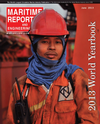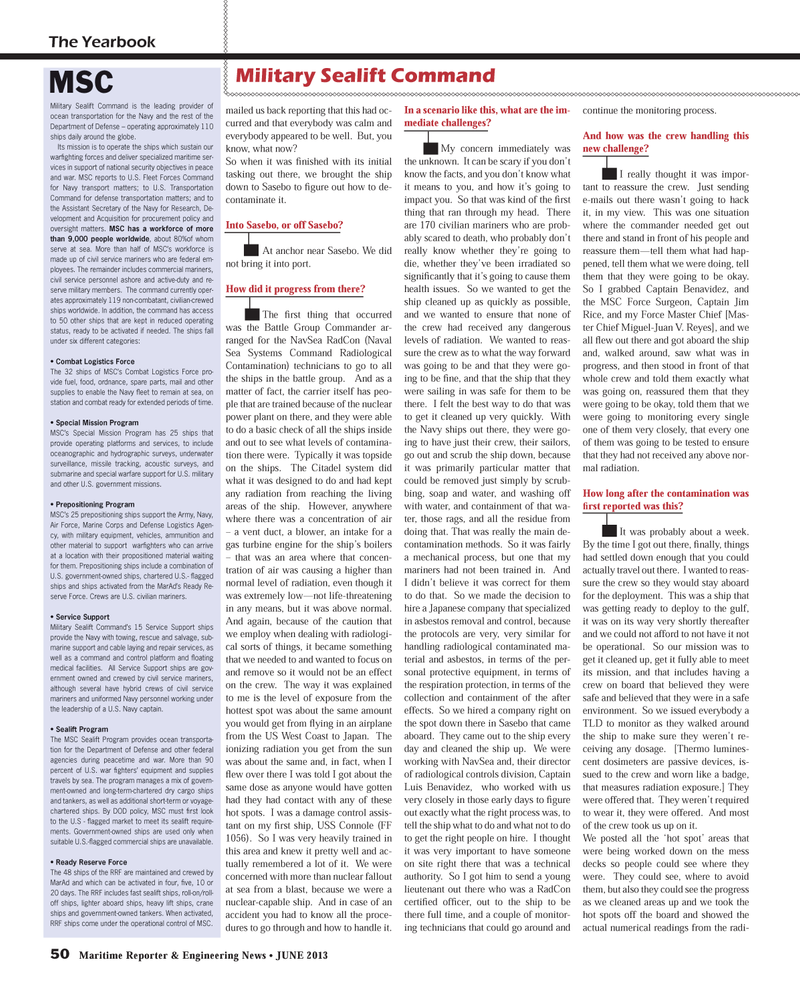
Page 50: of Maritime Reporter Magazine (June 2013)
Annual World Yearbook
Read this page in Pdf, Flash or Html5 edition of June 2013 Maritime Reporter Magazine
50 Maritime Reporter & Engineering News ? JUNE 2013 The YearbookMilitary Sealift Commandmailed us back reporting that this had oc-curred and that everybody was calm and everybody appeared to be well. But, you know, what now? So when it was Þ nished with its initial tasking out there, we brought the ship down to Sasebo to Þ gure out how to de- contaminate it.Into Sasebo, or off Sasebo? At anchor near Sasebo. We did not bring it into port.How did it progress from there? The Þ rst thing that occurred was the Battle Group Commander ar- ranged for the NavSea RadCon (Naval Sea Systems Command Radiological Contamination) technicians to go to all the ships in the battle group. And as a matter of fact, the carrier itself has peo-ple that are trained because of the nuclear power plant on there, and they were able to do a basic check of all the ships inside and out to see what levels of contamina-tion there were. Typically it was topside on the ships. The Citadel system did what it was designed to do and had kept any radiation from reaching the living areas of the ship. However, anywhere where there was a concentration of air ? a vent duct, a blower, an intake for a gas turbine engine for the ship?s boilers ? that was an area where that concen-tration of air was causing a higher than normal level of radiation, even though it was extremely low?not life-threatening in any means, but it was above normal. And again, because of the caution that we employ when dealing with radiologi-cal sorts of things, it became something that we needed to and wanted to focus on and remove so it would not be an effect on the crew. The way it was explained to me is the level of exposure from the hottest spot was about the same amount you would get from ß ying in an airplane from the US West Coast to Japan. The ionizing radiation you get from the sun was about the same and, in fact, when I ß ew over there I was told I got about the same dose as anyone would have gotten had they had contact with any of these hot spots. I was a damage control assis-tant on my Þ rst ship, USS Connole (FF 1056). So I was very heavily trained in this area and knew it pretty well and ac-tually remembered a lot of it. We were concerned with more than nuclear fallout at sea from a blast, because we were a nuclear-capable ship. And in case of an accident you had to know all the proce-dures to go through and how to handle it.In a scenario like this, what are the im- mediate challenges? My concern immediately was the unknown. It can be scary if you don?t know the facts, and you don?t know what it means to you, and how it?s going to impact you. So that was kind of the Þ rst thing that ran through my head. There are 170 civilian mariners who are prob-ably scared to death, who probably don?t really know whether they?re going to die, whether they?ve been irradiated so signiÞ cantly that it?s going to cause them health issues. So we wanted to get the ship cleaned up as quickly as possible, and we wanted to ensure that none of the crew had received any dangerous levels of radiation. We wanted to reas- sure the crew as to what the way forward was going to be and that they were go-ing to be Þ ne, and that the ship that they were sailing in was safe for them to be there. I felt the best way to do that was to get it cleaned up very quickly. With the Navy ships out there, they were go-ing to have just their crew, their sailors, go out and scrub the ship down, because it was primarily particular matter that could be removed just simply by scrub-bing, soap and water, and washing off with water, and containment of that wa- ter, those rags, and all the residue from doing that. That was really the main de- contamination methods. So it was fairly a mechanical process, but one that my mariners had not been trained in. And I didn?t believe it was correct for them to do that. So we made the decision to hire a Japanese company that specialized in asbestos removal and control, because the protocols are very, very similar for handling radiological contaminated ma-terial and asbestos, in terms of the per- sonal protective equipment, in terms of the respiration protection, in terms of the collection and containment of the after effects. So we hired a company right on the spot down there in Sasebo that came aboard. They came out to the ship every day and cleaned the ship up. We were working with NavSea and, their director of radiological controls division, Captain Luis Benavidez, who worked with us very closely in those early days to Þ gure out exactly what the right process was, to tell the ship what to do and what not to do to get the right people on hire. I thought it was very important to have someone on site right there that was a technical authority. So I got him to send a young lieutenant out there who was a RadCon certiÞ ed of Þ cer, out to the ship to be there full time, and a couple of monitor- ing technicians that could go around and continue the monitoring process. And how was the crew handling this new challenge? I really thought it was impor- tant to reassure the crew. Just sending e-mails out there wasn?t going to hack it, in my view. This was one situation where the commander needed get out there and stand in front of his people and reassure them?tell them what had hap-pened, tell them what we were doing, tell them that they were going to be okay. So I grabbed Captain Benavidez, and the MSC Force Surgeon, Captain Jim Rice, and my Force Master Chief [Mas-ter Chief Miguel-Juan V. Reyes], and we all ß ew out there and got aboard the ship and, walked around, saw what was in progress, and then stood in front of that whole crew and told them exactly what was going on, reassured them that they were going to be okay, told them that we were going to monitoring every single one of them very closely, that every one of them was going to be tested to ensure that they had not received any above nor- mal radiation.How long after the contamination was Þ rst reported was this? It was probably about a week. By the time I got out there, Þ nally, things had settled down enough that you could actually travel out there. I wanted to reas-sure the crew so they would stay aboard for the deployment. This was a ship that was getting ready to deploy to the gulf, it was on its way very shortly thereafter and we could not afford to not have it not be operational. So our mission was to get it cleaned up, get it fully able to meet its mission, and that includes having a crew on board that believed they were safe and believed that they were in a safe environment. So we issued everybody a TLD to monitor as they walked around the ship to make sure they weren?t re- ceiving any dosage. [Thermo lumines-cent dosimeters are passive devices, is-sued to the crew and worn like a badge, that measures radiation exposure.] They were offered that. They weren?t required to wear it, they were offered. And most of the crew took us up on it. We posted all the ?hot spot? areas that were being worked down on the mess decks so people could see where they were. They could see, where to avoid them, but also they could see the progress as we cleaned areas up and we took the hot spots off the board and showed the actual numerical readings from the radi-Military Sealift Command is the leading provider of ocean transportation for the Navy and the rest of the Department of Defense ? operating approximately 110 ships daily around the globe. Its mission is to operate the ships which sustain our war ghting forces and deliver specialized maritime ser- vices in support of national security objectives in peace and war. MSC reports to U.S. Fleet Forces Command for Navy transport matters; to U.S. Transportation Command for defense transportation matters; and to the Assistant Secretary of the Navy for Research, De- velopment and Acquisition for procurement policy and oversight matters. MSC has a workforce of more than 9,000 people worldwide, about 80%of whom serve at sea. More than half of MSC?s workforce is made up of civil service mariners who are federal em- ployees. The remainder includes commercial mariners, civil service personnel ashore and active-duty and re- serve military members. The command currently oper- ates approximately 119 non-combatant, civilian-crewed ships worldwide. In addition, the command has access to 50 other ships that are kept in reduced operating status, ready to be activated if needed. The ships fall under six different categories: Combat Logistics Force The 32 ships of MSC?s Combat Logistics Force pro- vide fuel, food, ordnance, spare parts, mail and other supplies to enable the Navy eet to remain at sea, on station and combat ready for extended periods of time. Special Mission Program MSC?s Special Mission Program has 25 ships that provide operating platforms and services, to include oceanographic and hydrographic surveys, underwater surveillance, missile tracking, acoustic surveys, and submarine and special warfare support for U.S. military and other U.S. government missions. Prepositioning Program MSC?s 25 prepositioning ships support the Army, Navy, Air Force, Marine Corps and Defense Logistics Agen- cy, with military equipment, vehicles, ammunition and other material to support war ghters who can arrive at a location with their propositioned material waiting for them. Prepositioning ships include a combination of U.S. government-owned ships, chartered U.S.- agged ships and ships activated from the MarAd?s Ready Re- serve Force. Crews are U.S. civilian mariners. Service Support Military Sealift Command?s 15 Service Support ships provide the Navy with towing, rescue and salvage, sub- marine support and cable laying and repair services, as well as a command and control platform and oating medical facilities. All Service Support ships are gov- ernment owned and crewed by civil service mariners, although several have hybrid crews of civil service mariners and uniformed Navy personnel working under the leadership of a U.S. Navy captain. Sealift Program The MSC Sealift Program provides ocean transporta- tion for the Department of Defense and other federal agencies during peacetime and war. More than 90 percent of U.S. war ghters? equipment and supplies travels by sea. The program manages a mix of govern- ment-owned and long-term-chartered dry cargo ships and tankers, as well as additional short-term or voyage- chartered ships. By DOD policy, MSC must rst look to the U.S - agged market to meet its sealift require- ments. Government-owned ships are used only when suitable U.S.- agged commercial ships are unavailable. Ready Reserve Force The 48 ships of the RRF are maintained and crewed by MarAd and which can be activated in four, ve, 10 or 20 days. The RRF includes fast sealift ships, roll-on/roll- off ships, lighter aboard ships, heavy lift ships, crane ships and government-owned tankers. When activated, RRF ships come under the operational control of MSC. MSCMR #6 (50-57).indd 50MR #6 (50-57).indd 505/31/2013 9:55:00 AM5/31/2013 9:55:00 AM

 49
49

 51
51
